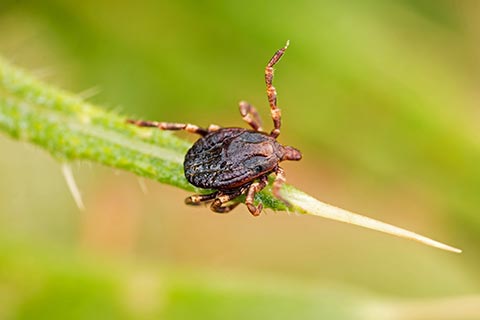Avoiding dangerous ticks
What is a Tick?
Ticks are very small parasites that feed on the blood of their hosts (preferably animals). They can be found across the UK in both towns and countryside and are usually more active March – October but can also be active during the winter on mild days.
Ticks do not jump or fly, but climb a nearby piece of vegetation and wait for a passing animal or human to catch onto.
Here’s what you need to know about the problems that ticks can cause for your dog, how to spot them, and tips on how to avoid them.
The dangers of Ticks for your dog
The main concern with Ticks is the potential for spreading disease.
Lyme Disease and babesiosis are two examples of conditions that can be spread through Ticks and both can potentially be serious for your dog. Babesiosis has proven fatal on at least one occasion in the UK.
Ticks can also infect humans. Lyme Disease can be contracted by humans through infected Ticks, for example.
How to spot a Tick
Ticks can come in a few different sizes and colours so it’s not necessarily as easy as you might think to know when you’ve seen one on your pet.
If they have fed recently, they will be on the bigger side whereas you can expect them to be smaller if it’s been a while since this happened. This can make them anything from a pinprick to the size of one of your nails!
Whatever the size, they are round or oval in shape and can be cream through to brown or dark grey in colour.
If they are attached to your pet, you won’t be able to see their legs or the part of their body that is actually piercing the skin. This means that you’ll see a small egg or stone like object on your pet’s skin, something you can usually feel if you run your fingers through your pet’s fur.
What to do if you find a Tick
The golden rule with Ticks is this: don’t try to scrape it off your pet’s skin.
It’s very unlikely that you’ll be able to fully remove the Tick in this way so you risk leaving parts of it behind and encouraging an infection and other knock on effects. Not a nice thought and definitely not nice for your pet either!
The best way to remove a Tick is to grasp it by its head close to the skin so you stand a much better chance of completely removing it. Try not to squeeze the tick’s body as you pull as this can increase the risk of infection. Using a tick remover tool makes this task easier.
If you don’t feel confident doing this yourself, another option is to take your pet to the vet and ask them do it instead.
How to prevent problems with Ticks
It’s good practice to check your dog every time you come back from a walk, just in case any Ticks have latched on. This is particularly important if you have been walking in areas that are quite damp and humid as ticks are more a potential problem in these conditions. (Ticks may have jumped on, but as yet haven’t started to bite – so it’s important to brush off pets and your clothing before going inside).
If a Tick has started to bite, the quicker it’s removed the less chance there is of it passing diseases onto your pet.
It won’t always be possible to avoid areas where there are Ticks but you can protect your dog by using products that repel Ticks or encourage them to die if they do manage to latch on.
As with flea treatments, Tick products come in a few different forms such as tablet, spot ons and collars. Speak to your vet about the best option for your dog if you decide to use these type of products.
To protect yourself on dog walks, covering up is the best way to limit your potential exposure to Ticks. For example, you can cover up with long sleeved tops and minimise the chances of Ticks biting your legs by tucking trousers into socks – avoid long grass too.
Consider the use of products, check your dog regularly and ensure you have a Tick remover for when the time comes when you need to remove one.
Below is a selection of some of our popular tick products.
